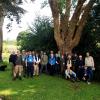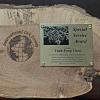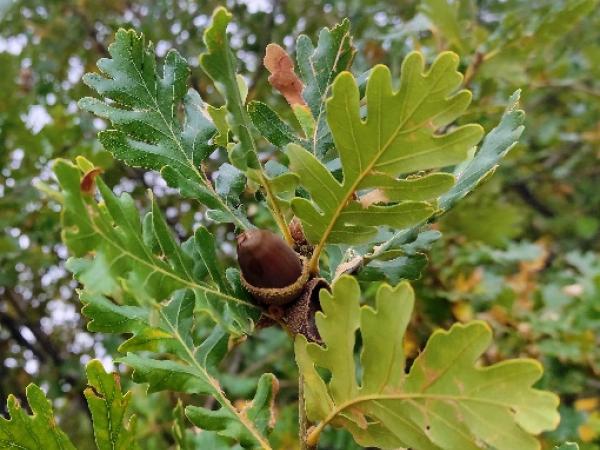Editor's Picks
Plant Focus
The 2025 edition of UK Oak Open Days included two gardens with excellent collections of Quercus, Tregrehan and Caerhays. On this occasion we also took in other genera in the Fagaceae family, particularly Lithocarpus and Castanopsis, which are also well represented in these Cornish gardens.
Saturday, June 7: Caerhays Castle Gardens
It was a Celtic morning as we parked at Porthluney Beach next to Caerhays Estate,with low grey clouds and a damp feel in the air. We walked through the Bottom Lodge past the Lake towards the 19th century castle, its round tower reminiscent of Windsor Castle. We were met and given a cheering welcome introduction by Charles Williams, the owner.

©Roderick Cameron
We set off and stopped at a large Lithocarpus pachyphyllus, which was in flower, with its conjoined fruit from the previous season on the ground beneath.

©Roderick Cameron
Our guide then dived off the trail to show us a Quercus myrsinifolia or Q.glauca. We saw two trees, originally part of a hedge of the same species, one of which had been severely damaged by a falling branch. The species are similar, but Q. glauca has appressed silky hairs on the leaf underside (appressed means flattened along the surface). The epithet refers to the glaucous colour of the underside, a blueish-grey colour with a fine waxy bloom like a plum. Both species share purplish or brownish spring growth, while the leaf dimensions overlap, with Q. myrsinifolia being narrower and longer: Q. myrsinifolia has leaves that measure 5-18 cm x 1.5-5 cm, compared to 6-13 cm 2-5.5 cm for Q. glauca. Quercus myrsinifolia was our host’s identification, while among our group Q. glauca was the preferred diagnosis, based primarily on the presence of the appressed hairs, observed under a hand lens.
We continued through the drizzle finding Q. greggii, Q. morii, Q. kiukiangensis, and Lithocarpus uvarifolius with excellent leaves.

©Roderick Cameron
As contrast between the oaks was a series of Crinodendron sp. with their large red fruits, Eucryphia ×intermedia ‘Rostrevor’ with subtle pink markings on its flowers, Sassafras albidum, and a Styrax collection. This included Styrax formosanum var. formosana, S. suberifolius var. hayataianus (formerly a variety of S. formosanum), and S. hemsleyanus with globular flowers.

©Roderick Cameron
We were in a temperate rain forest with massive Magnolia ×veitchii hybrids, heavy branches hanging low, and ancient rhododendrons. We saw a Q. semecarpifolia with prominent male catkins, some just opening.

©Roderick Cameron
We ascended to new planting on a ridge, passing Q. ×bushii ‘Seattle Trident’, with thick leathery leaves in a triangular shape, and reaching Q. ‘Belle d’Aquitaine’, with characterful leaves. The rain became heavier as we descended, and we were revived by good choices of lunch we could enjoy in the Georgian hall of the castle.

©Roderick Cameron
We had had a splendid morning, and were most appreciative that for a century the Williams family had produced such keen and knowledgeable collectors. In the afternoon we were treated to presentation delivered by Roderick Cameron, prepared in collaboration with IOS member Joeri Strijk, which provided an overview of the systematics of Fagaceae, focusing on Lithocarpus and Castanopsis, in addition to Quercus. This proved useful information for these Oak Open Days, where we saw several species of these other two genera.
Sunday, June 8: Tregrehan Gardens

Next day our tour started in bright sunshine, in the walled Garden at Tregrehan, a formal calm area. The excitement started with a bright purple unnamed Hydrangea from Gan Shan, then a series of massive trees, including some champions and an Araucaria araucana with extensive and distant root suckers.

©Roderick Cameron
A puzzle from 1892 planting: a tree labelled as a Champion Tree and identified as Q. serrata. It is grafted at 1.3 m, and we saw leaves sprouting from the rootstock that appeared to be Q. cerris. This aroused suspicions as it is common practice to graft oaks on rootstock in the same section, to avoid incompatibility and failed grafts. Quercus serrata is in Section Quercus, while Q. cerris is in Section Cerris and in a different subgenus. The canopy of the tree was too high up to be able to identify the species, but we found a fallen twig that was clearly Q. acutissima, which is in Section Cerris. The Tree Register has been informed of the misidentification, which means the tree loses its Champion title, as it is outcompeted by taller and wider specimens of Q. acutissima in the British Isles (note the risks you run when inviting the IOS to view your oak collection!).

A vast Prunus padus. A sleek Huodendron biaristatum with two-tone smooth dark trunk, slowly shedding bark. Quercus semecarpifolia with good indumentum, which develops through the year especially on the sunny side of the tree. A New Zealand Rhododendron ‘Pukeiti’, late flowering with pink blooms and good scent.

©Roderick Cameron
We paused at the reconstructed Molossus Dog Statue, where the 1840 Yew walks meet in an “L” shape. Originally planted with alternate rows of yew and holm oak, later a shelter belt of Nothofagus fusca was added.

©Stephen Wood
We admired Philadelphus schrenkii with impressive globular flowers, Sassafras randaiense from Taiwan; some large Q. schottkyana, Q. acherodophylla, Q. myrsinifolia, Q. castaneifolia, and Q. morii with excellent new growth. A delightful Kalmia latifolia appropriately named ‘Pink Charm’. Other notable oaks were Q. pannosa, albeit a shrubby tree, Q. aquifolioides with rich indumentum, and a Q. palustris × texana hybrid.

©Roderick Cameron
We noted Q. tatakaensis from high altitude Taiwan with nice new growth, and Q. tarokoensis, first described from Taroko Gorge in Taiwan, besides a group from Panama: Q. copeyensis and Q. seemannii. And Q. tungmaiensis from Tibet, as well as rare Q. marlipoensis from South Yunnan. Also a healthy Gunnera insignis (the epithet means "distinguished, notable"), a most tender species, which also grows at Iturraran Botanical Garden in Spain.

We also saw the oak with the same distinguished epithet (Quercus insignis), displaying its striking maroon new leaves in copious quantities.

©Roderick Cameron
There was even a relaxation area with seating under tree ferns by the stream. We were lucky to be revived by an excellent lunch, today outside. The bones of this garden were laid down in the nineteenth century, and have been brilliantly developed by Tom and Jo Hudson.

The visit closed with a Silent Auction, in which Tom offered many rare plants, sparking a lively bidding contest. The proceeds were generously shared by Tom and Jo with the IOS, as a donation to the Oak Conservation and Research Fund.















